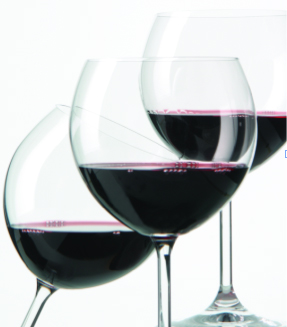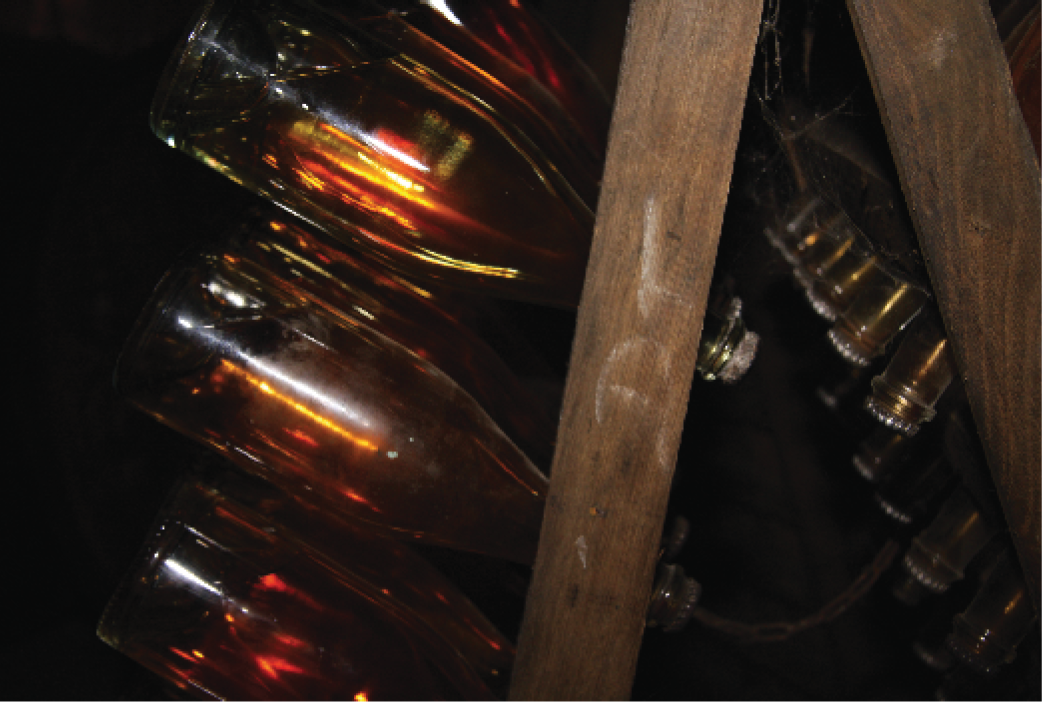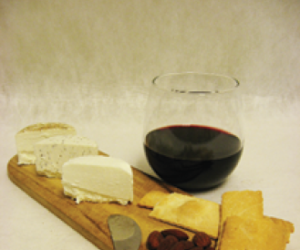
The name Meritage is a blend of the words merit and heritage (and pronounced to rhyme with the latter). But beyond a commitment to using the same grapes as those used in the great wines of Bordeaux, making a Meritage blend is mostly a matter of a winemaker’s own tastes and preferences. Like most things in winemaking, bring four winemakers together and you’ll get four different opinions.
Which is exactly what we’ve done here. We asked four commercial winemakers the same series of questions about making a red Meritage, and while there was one universal theme of letting the grapes determine your choices, by and large there were a lot of different thoughts on how to make a great Meritage wine. The “ingredients” are the same – the six grape varieties that are used to make the wine (as agreed upon by the Meritage Alliance): Cabernet Sauvignon, Cabernet Franc, Merlot, Malbec, Petit Verdot and Carmenère. The variations are endless.
Meritage Roundtable Winemakers
Mark Topel of Topel Winery in Hopland, California, in the Mendocino AVA. Topel and his wife Donnis have been growing and making wines, including Meritage, for more than 30 years. The couple have 25 acres of their estate planted out in several varieties, and are focused on sustainable agriculture and winemaking techniques.
Bruce Nicholson of Inniskillin Niagara, Niagara-on-the-Lake, Ontario, Canada. Nicholson has been winemaker at the Inniskillin Niagara facility since 2007, after working at the Inniskillin Okanagan estate, in British Columbia, for 20 years before that. While Inniskillin is primarily known for its icewines, the winery produces a wide variety of wines, including Meritage.
Mitch Cosentino of PureCru Wine in Napa, California. Consentino started the Cosentino Winery in 1986, later leaving the winery in 2010. He’s a consulting winemaker throughout the Napa Valley, and is a founding member of the Meritage Alliance. His latest project, PureCru, is a new label focusing on high-end blended wines out of the Napa Valley.
Josh Stein, of Stein Family Wines, is probably known for his philanthropy as much as for his wines, including Same Sex Meritage. He has been active in Tempranillo Advocates Producers and Amigos Society (TAPAS), as well as in the Meritage Alliance.
Questions
What do you blend and what are your blending goals?
Mark Topel: I generally use Cabernet Sauvignon as a base with a substantial proportion of Merlot, and Petit Verdot, and then I might add Cabernet Franc or Malbec. I like Cabernet Franc if you can get it right. I think Merlot is a wonderful blending grape, but by itself it’s kind of like muzak. On the other hand the Cabernet Sauvignon grapes that we grow here are the match of anything in the world. It just depends on the vintage but it will always have Cab, Merlot, and Petit Verdot.
Bruce Nicholson: I have made Meritage based with Carmenère and I have made it from mostly Merlot. In the past I also made it based from Merlot and Cabernet Sauvignon and Cabernet Franc. I’m always looking for the best blend. I like to start with a lot of Merlot and I try to have a balance of ageability and drinkability.
Mitch Cosentino: The style for our M.Coz Red Meritage Napa Valley was set in the late 80s/early 90s. Inspired by the 1986 First Growth Bordeaux wines. It is a more Cabernet Sauvignon/Cabernet Franc-directed wine, with Merlot in the mix for complexity and texture. Occasionally Petit Verdot and Malbec may be used to add or enhance density, color and/or depth. It is a rich and complex wine with balance and it is more food friendly than just varietal Cabernets.
For our white Meritage (PURETY White Meritage Napa Valley), the style is inspired by the rarest wine from Bordeaux, which is actually white not red — Haut Brion Blanc — a wine that is roughly equal parts of Sauvignon Blanc and Sémillon. A complex blend of brightness and richness in a crisply balanced (mostly from the Sauvignon Blanc) wine that has an uncommon broadness and rich character (from the Sémillon) precisely defined, built to age (timewise) like a red and yet make the mouth water while young. We call it a red-wine drinkers white wine. It is extremely versatile with a wide selection of foods.
Josh Stein: Blending is the fun of winemaking. If you think of it as cooking with grapes, the ingredients and the spices together lend themselves to the ability to create themes or moods; the same goes for blending in winemaking. We start with what we want the wine to be in conjunction with the creative elements like brand and label design. The beautiful thing about blending is I put together softer wines and create a final product to match what we need for sales. If we had not allowed ourselves to blend, it would have been very difficult to do so at all or with consistency.
What yeasts do you use and do you put your Meritage through malolactic fermentation?
Mark Topel: That depends. Our wines ferment mostly with what’s our indigenous yeast in our wineries. On occasion if we have what I think is going to be a particularly difficult wine, I’ll use a commercial yeast that will tolerate a high alcohol. I have a wonderful yeast strain in the winery and I’m scared that if I know what it is, it will stop working. So much for a classical education.
All my reds go through MLF because I think you get a nice roundness and better mouthfeel by finishing with malolactic. Most of the Meritages that we make we assume they’re going to last 30 to 40 years and you don’t want anything in there that’s going to pop off.
Bruce Nicholson: I use Lalvin ICV-254®. I’ve been using it forever and I think it’s been very successful in our Meritage wines. Whether it’s long or slow you want (the fermentation) to finish. Everything goes through MLF. I do that with all reds. I want that softness. I don’t want sharpness in my red wines.
Mitch Cosentino: We don’t get too esoteric with the yeasts (mostly older styles, but no wild yeasts) unless something is different and difficult with a certain vintage. The red wines go through malolactic fermentation, while the whites do not as it can destroy the wine’s natural balance. We get plenty of richness in the white due to the amount of Sémillon that is barrel fermented on the lees.
Josh Stein: I use standard commercial yeasts. I used to experiment a lot, but I now use some standard strains, depending on final outcomes: softer, richer, bolder, etc. Yeast alone doesn’t determine any of that, really, but in concert with different production practices will yield the desired end results. All reds undergo MLF as a natural course of aging in barrel.
What kind of aging do the wines see and what kind of oak do you use?
Mark Topel: I like to age big reds for somewhere between 30 and 36 months in the barrel. I don’t think 22 months is enough. There are no rules that are hard and fast. You have to taste and behave accordingly. I use French oak because I think it tastes better.
Bruce Nicholson: For Meritage, I have a little bit of flexibility. I’ll leave it in oak between 10 and 15 months and I will use anywhere from 80 to 20 percent French and the remaining American, with usually 30 percent in new oak. Meritage is meant to be a high-end, full-bodied wine. It’s not a light sipping wine.
Mitch Cosentino: The reds are barrel aged well into the third year (30 to 36 months). Each vineyard lot is done separately then the blend goes into a tank and remains there for four to six weeks before bottling. This allows a more precise and exacting blend with more integration of the oak into the fabric of the wine and a more resolved feel and finish.
The white varietals are made differently. The Sauvignon Blanc is fermented in stainless steel and partially aged in two- and three-year-old French oak barrels. The Sémillon is completely barrel fermented and aged (10 to 12 months) in specially-made French oak barrels designed for white Bordeaux. It is fermented on the lees and stirred weekly. No Malolactic is performed in either.
Josh Stein: We age about eighteen months in barrel to again soften the wine and allow for as rounded and soft a final product as possible, and use a mix of two- and three-year-old barrels. As with any cooking spice, when it comes to oak, if it dominates, it’s not helping to produce a synthesis greater than its parts. Oak absolutely gives body to reds, but if you can smell and taste the oak, the wine is out of balance in my opinion.
How do you achieve balance when making Meritage?
Mark Topel: All the wines are balanced from the way I grow them and pick the grapes and vinify them. I don’t pick by Brix, I pick by ripeness. I’ll evaluate each of the components separately, then by Christmas week of their second year, I’ll start blending. Blending is like magic; it’s like a mystery tour. Sometimes you’ll be really surprised. For example, you start with a base of premium Cabernet where there’s a large proportion — it can even be 40 percent. My practice is to add Merlot because that tells me how the Cabernet is structured. Then I add Petit Verdot; it’s a brighter wine that picks up the accents. Then I’ll add some Malbec or some Cab Franc. When it comes to blending, everybody’s an expert, actually. It’s just people’s taste. You know when something’s really good when you taste it.
Bruce Nicholson: I ferment and barrel age everything separately. I start my potential blend with Cab Francs, and then when I put the blend together I drink it. I’ll fill a bottle with a potential blend and let it rest awhile, then taste it. I put myself into the consumer’s shoes and if I don’t like it, I’ll just try another blend. It’s getting to know the particular vineyard these grapes are coming from.
Mitch Cosentino: I achieve balance through proper harvest picking times and winemaking decisions and techniques. After that it’s a matter of exact and specific blending.
Josh Stein: Everything we make has some blending in it, it’s not just Meritage blends; even if only different lots of the same varietal. Why? Because if the goal is to make good wines people want to drink, I am not going to tie my hands where I don’t have to based on arbitrary “rules” no one’s mouth or nose cares about. Balance is absolutely the key to great, enjoyable, high-scoring wines, and you won’t achieve it by accident.
What tips do you have for an amateur winemaker?
Bruce Nicholson: If you’re a home winemaker, you want to age the (red) wines 15 to 16 months in oak. Keep these batches of wine separate so that you have the flexibility to blend. If it’s a big year and you’ve got a big, high tannin, high alcohol wine, be aware that might not be as drinkable as soon as other vintages. It’s having an end point for what you want to see. If it was a mediocre year or with low tannins, the alcohol is not overly high, you can drink it sooner. Some wines have more ageability. If you’re talking about Meritage, you have wine that has great structure. Keep your wines separate and give them some time to marry when you do your final blending. Put some together then let the varieties get to know each other. Experiment and have fun with it. If you have the ability, let it sit for a bit, even if it can breathe, keep that in mind. Keep that flexibility alive. Come back to it maybe a couple times before you finalize your blend and bottle it. Learn from your previous vintages, too. The bottom line is make sure it’s fun.
Mitch Cosentino: Don’t have a minimum quantity in mind when you make the wine, only make what is absolutely the best regardless of how much wine you end up with. Also don’t be afraid to skip a vintage that compromises the quality and desired style you want.
Josh Stein: Start with the best ingredients you can get and don’t be afraid to be creative. No one pushes the envelope by doing it the “right” way; do it your way and you will like the result!







